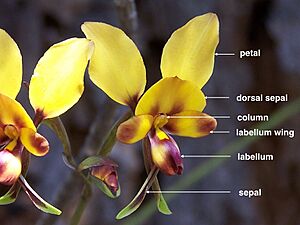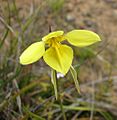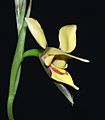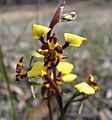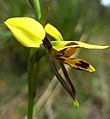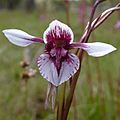Donkey orchids facts for kids
Quick facts for kids Donkey orchids |
|
|---|---|
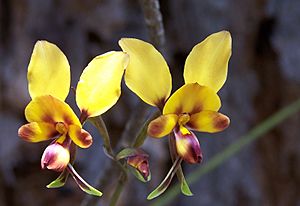 |
|
| Diuris corymbosa | |
| Scientific classification |
|
| Kingdom: | Plantae |
| Clade: | Tracheophytes |
| Clade: | Angiosperms |
| Clade: | Monocots |
| Order: | Asparagales |
| Family: | Orchidaceae |
| Subfamily: | Orchidoideae |
| Tribe: | Diurideae |
| Subtribe: | Diuridinae |
| Genus: | Diuris Sm., 1798 |
Diuris, often called donkey orchids, bee orchids, nanny goat orchids, or pansy orchids, is a group of over sixty types of flowering plants. These unique plants belong to the orchid family, Orchidaceae. Most Diuris species are found only in Australia, but one type also grows in Timor.
The name "Diuris" comes from the way some parts of the flower hang down. However, the common name "donkey orchid" is much easier to understand. It comes from the petals, which look like the ears of a donkey! Many of these orchids have bright yellow flowers with darker marks. Scientists think they might trick insects into visiting them by looking like other flowers that offer sweet nectar.
Contents
What Do Donkey Orchids Look Like?
Donkey orchids are ground plants. This means they grow in the soil, not on other plants or trees. They are also perennial, so they live for more than two years. Each year, they grow new parts and then lose their leaves, like some trees do.
These orchids usually have a few thin roots and one or two special underground storage parts called tubers. Their stem is short and stands straight up. At the bottom of the plant, there are usually one to ten leaves that look like blades of grass.
The flowers grow on a thin, strong stalk. They are often brightly colored and turn upside down as they grow, which is common for orchids. The top part of the flower, called the dorsal sepal, is shorter but wider than the two side sepals. It forms a little hood over the center of the flower. The two long, thin side sepals hang down like tails.
The petals are special. They have a narrow base and then spread out wide, looking just like donkey ears. Like all orchids, one petal is very different from the others. This is called the labellum. It often has three parts, with the middle part folded. The side parts might spread out wide and sometimes have a wavy edge. The central part of the flower, called the column, is short with small wings.
Donkey orchids flower at different times depending on the type. Most bloom between September and November. Some, like D. brumalis, can flower as early as June. Others, like D. emarginata, might flower as late as January. After flowering, the plant produces a thin seed pod. This pod splits open to release up to 100 tiny seeds, each with a wing to help it fly away.
How Did Donkey Orchids Get Their Name?
The Diuris group of orchids was first officially described in 1798. This was done by a scientist named James Edward Smith. He wrote about them in a scientific paper.
As we learned, the common name "donkey orchid" comes from the petals that look like donkey ears. The scientific name "Diuris" also has a meaning. It comes from two ancient Greek words: dis, which means 'double', and oura, which means 'tail'. This refers to the two long, narrow sepals that hang down like tails from the flower.
Where Do Donkey Orchids Live?
Donkey orchids can be found in all states of Australia, but not in the Northern Territory. One species, D. fryana, is also found in Timor.
In New South Wales, many species grow among grasses in dry forests. In Western Australia, most prefer wet places, like swamps near the coast or rocky areas near granite. Donkey orchids usually grow alone or in small, spread-out groups. Most of them live in lower areas, but one type, D. monticola, can grow high up in the mountains, even at 1,800 meters (about 5,900 feet) above sea level!
Some donkey orchids flower much more after a bushfire. For example, D. purdiei will only flower after a summer fire. In areas where fires happen often, the orchid's tubers stay safe underground. This means the fires don't harm them.
How Do Donkey Orchids Attract Insects?
Donkey orchids have bright colors, just like other flowers that attract insects. These insects include wasps, bees, and flies, which help pollinate plants. However, Diuris orchids are a bit tricky! They don't actually make any sweet nectar, which is the food that many insects look for. Most of them don't even have a scent.
Scientists believe that Diuris orchids trick insects. They pretend to offer food when they don't have any. This idea has been tested on at least one species, D. pardina, and it seems to be true. The insects visit the flower, hoping for a meal, and in doing so, they help the orchid spread its pollen.
Gallery


